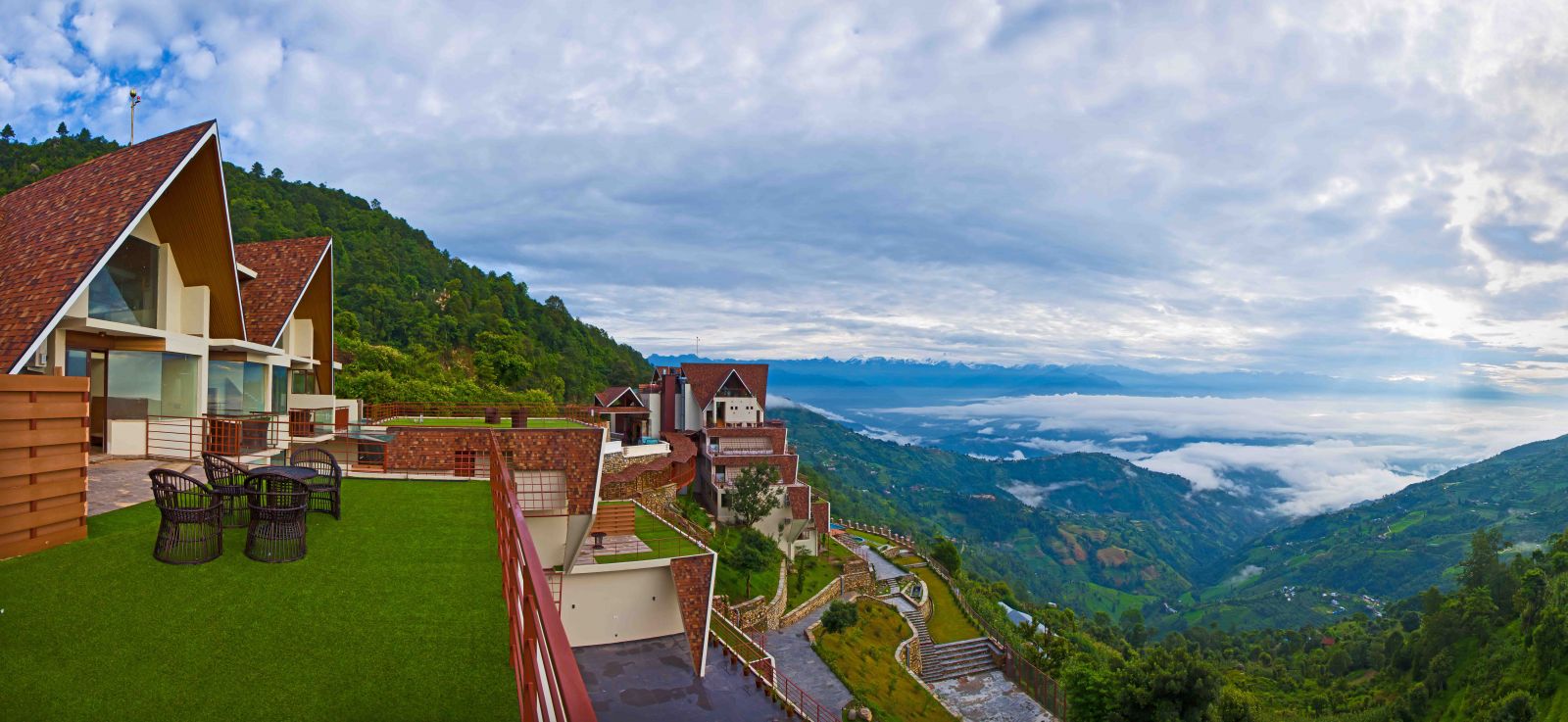
The Magic of Mystic Mountain
Mystic Mountain Hotel: When the point of perfection meets the point of height
Thirty-two kilometers from Kathmandu, Nagarkot is a serene hill with a 270-degree panoramic view of the Himalaya. Driving along the crooked paths uphill, you can see Mystic Mountain Hotel, the sixty-room resort, standing tall on the scenic sloping terrain of Nagarkot. As soon as you step inside its welcoming doors, all your fatigue, exhaustion, and weariness brought about by dust and travel will vanish immediately—the wind fans the sweet fragrance of many flowers all around, while the grand view of terrain and sky embracing each other is a sight for sore eyes.
|
|
Take two steps farther to the viewing platform, and you will be able to capture the whole landscape—right in front is the village, packed with greenish terraced fields and colorful compact households; turning around, you can see the modernized hexagon-shaped building blocks. Sanjay Lal Shrestha and his wife Romi filled this design with love. Sloped wings have been introduced so that the building is clinically inserted in the form of a stepped terrace. The mass has been reduced, with the edges of the building blurred into the surrounding landscape. Additionally, this hotel is one of the few hotels to be built within just three years, which shows the team’s strong capability of integrating resources.
Uniformed staff will guide you to your room. To satisfy varying consumer demands, Mystic Mountain Hotel has diversified their types of rooms into executive suites, suite rooms, and deluxe rooms. Each room has its own unique design. A standard room is generally equipped with a Mitsubishi air-conditioner and a Sony TV, and also a spring soft mattress that can effortlessly get you immersed in the cozy ambience with ease. Beyond expectation, you can find a small flashlight near the light switch, a locker box inside the closet, and a balcony from which the Himalayan views can be enjoyed, as well. A very convenient facility of this hotel is its 24-hour room service. “This is rare in Nepal,” says Mahesh Raj Dhakal, Director of Culinary.
For more leisure and amusement, guests can find pleasure in the spa and gym, and in the Jacuzzi and swimming pool. The hotel insists on changing the pool water every two days, despite the high cost each change entails. If there is a health emergency, the nearest hospital can be reached within just five minutes.
Director of Culinary Mahesh Raj Dhakal: Increasing fusion-mania, consistent hard-working, vibrating hospitality
Mahesh is the owner of lots of beautiful titles—the youngest executive chef in Nepal; the first Nepali to be presented with the Worldwide Hospitality Award-2015 in Best Professional Success category at France; the chairman of Hospitality Foundation of Nepal, etc. These achievements would not have been gained without his abundant experience of working in Dubai luxury hotels and learning from Michelin Star chefs. His fancy on fusion is based on his conviction, “My food is more than Nepali”, an example of which is Nepali salmon mixed with exotic, spicy Chinese meatballs and fused with Thai chili and organic vegetables, accompanied by Western bakery items. Whatsoever a guest wants to taste, Mahesh can figure out the best result.
Instead of "Hello / Namaste", he always greets people with "Coffee or tea?" On the sleeve of his working suit are two pens, ready always to record customers’ feedback. With locals, he is extremely willing to share with them how to cook fusion cuisine. With international guests, he is always well-prepared for any cuisine adapted to exotic flavor.
Beverage Manager Tara Adhikari: Creating satisfying flavors with speed and precision
Adhikari's professionalism can easily be discerned from the way he types on his smartphone's keyboard—to finish every word, he will raise his arm high quickly and flexibly like a music conductor, and then his fingers hit the keyboard accurately, but silently. Speed and precision are exactly what a bartender needs to be equipped with, yet not so easy to develop.
When he is making a shaken cocktail, he deftly lifts the vodka up from a variety of alcohols on the counter top, and then in one fluid motion, tilts the bottle over and pours into an empty jigger. The liquor is subsequently poured into a measuring tumbler—precisely 2 ml—that's all he wants. This kind of fluidity should be attributed to his rich experience of working as a bartender in countries famous for their golden-quality hospitality, such as Dubai and the United Arab Emirates.
Instead of mixing drinks flamboyantly, he prefers to mix drinks precisely. "I know that my guests do not fancy superb performance, but rather, satisfying flavors," he says. Bearing this in mind, he always places his measuring tumbler within his guests' vision, so that they can know their bartender does mix the drinks accurately and honestly. Also, he dwells on a lot on details. "Some bartenders might complain that their guests are too demanding, but I am much more demanding than my guests," he says with a smile. For garnish, he will hold his breath just to keep a tiny cherry right in the center of the glass! For flavor, he will select Rubik Cube-like ice cubes and carve them into squares—in this way, the drinks can be kept from becoming watery.
Moreover, he regards the process of mixing a drink for his guests as a mutual learning process. Any feedback is heartily welcomed. Any chance for improvement and innovation is to be grasped. He says that he would never be satisfied with just the capability of reciting countless recipes and mixing over 200 types of drinks. He is now even planning to host the very first bartending competition in Nepal, which he believes can enliven Nepal's bartending industry.


%20copy.jpg)
%20copy.jpg)
%20copy.jpg)
%20copy.jpg)
%20copy.jpg)









